SAND/3: SDN-Assisted Novel QoE Control Method for Dynamic Adaptive Streaming over HTTP/3
Abstract
:1. Introduction
- In Section 3, we describe the overall design and interaction of the proposed QoE Control method for DASH over HTTP/3, whose main strength is its simplicity, and how SDN can orchestrate network-, transport-, and user-level components.
- In Section 5, we present a comprehensive evaluation of some of the most common adaption algorithms and the effects on QoE when they use HTTP/3 compared to the current deployment.
2. Related Work
2.1. TCP-Based SDN Solutions for DASH
2.2. Non-TCP-Based SDN Solutions for DASH
- (P1) Single-component optimization: Most solutions focus on a single component optimization (network, client, or server).
- (P2) Transport ossification: Most solutions assume TCP as the only protocol for end-to-end communication for HTTP, which creates a performance bottleneck.
3. SDN-Assisted Novel DASH QoE Control Method over HTTP/3 (SAND/3)
- User module: This module collects the end-user identity and the associated devices from a third-party service in which the user is subscribed (e.g., Netflix) and stores them in a repository called user profile. We assume that this information will be available and provided by the third-party service. The profile consists of a registry of tuples comprised of a user identification number, associated devices, and preferences. Thus, when a device requests a video segment throughout an HTTP message, the device manager fetches the associated profile and collects the basic specifications (e.g., display size, available memory, buffer size, type of device, and subscription plan) and assigns a user priority for the current video playback. For instance, a user with a premium subscription to Netflix streaming a video on a SmartTV would have a higher priority than a user with a free account on a mobile device since their quality requirements are different.
- Network module: This module performs traffic engineering, by routing the packets via the most suitable paths that offer the best Quality of Service (QoS). To do so, first, the network status is continuously monitored by the Network Monitor sub-module, which collects the statistics of all the elements in the network, allowing a better estimation of the available resources. As part of this module, the Topology Manager updates the network device status, and it is triggered every time there is a change in the topology. Finally, the Routing Handler calculates the end-to-end paths to handle the traffic according to the priority assigned to each user. For simplicity, we create k different paths using a modified version of the well-known k-maximum disjoint paths Suurballe’s algorithm [27], where k is the number of categories in the application policy, e.g., if the quality categories are high, normal, and low, then . The cost of the path (weight) is calculated using Dijkstra’s shortest path algorithm, having each link a cost based on network parameters or a combination of them, i.e., available bandwidth, delay, packet loss and so forth. In the current implementation, we use the delay as the only factor to calculate the path cost, but these can be easily extended to more elaborate weights.
- Application module: Based on the user profile, the current state of the network, and the specific service policies, the QoE Manager sub-module recommends the most suitable settings for the transmission, which is handled by the Transport Handler sub-module. Note that the Transport Handler sub-module is in charge of performing the transport connection using QUIC protocol.
4. An Overview of SAND/3
5. Evaluation
5.1. Test Environment
5.2. Use Case
- Throughput-based adaption (TBA) [34]: TBA starts the transmission by requesting the lowest available bitrate and, based on the average network throughput, the following segments will be selected in an additive increasing, multiplicative decreasing (AIMD) manner.
- Buffer-Based adaption (BBA) [35]: While other bitrate adaption approaches focus on throughput capacity prediction, BBA uses only the buffer occupancy to request the initial segment and then, if needed, estimates the capacity. BBA decreases the re-buffering events while the playback bitrate increases. The second version of this algorithm (BBA-2) was part of a large-scale experiment on Netflix, which achieved about 10–20% decreased re-buffering. Specifically for the experiments, after some preliminary results, instead of using a buffer size equal to the video segment size, as would usually be done, we used three times that value to make a fair comparison with the other compared algorithms. In Table 2, we describe a complete list of the BBA parameters used in the experiment.
- Segment Aware Rate Adaptation (SARA) [36]: Contrary to other ABR algorithms, which assume equal segment sizes, SARA takes into account the variation in segment and buffer sizes, so that it allows a more accurate prediction of the next segment. The configuration parameters used in the experiment are described in Table 3.
- TCP-only approach: In this approach, the transmission of HTTP is over a TCP stream, as the current default solution would behave.
- QUIC-only approach: HTTP is sent on top of QUIC, emulating the way HTTP/3 would work but only changing the transport protocol without further improvements.
- SAND/3: The proposed scheme was used on top of QUIC and applying the process explained in previous sections.
5.3. QoE Metrics
6. Results
6.1. Number of Stalls
6.2. Media Throughput
6.3. Video Quality Shifts
6.4. Average Downloaded Video Files
7. Discussion
8. Conclusions and Future Work
Author Contributions
Conflicts of Interest
References
- Langley, A.; Riddoch, A.; Wilk, A.; Vicente, A.; Krasic, C.; Zhang, D.; Yang, F.; Kouranov, F.; Swett, I.; Iyengar, J.; et al. The QUIC transport protocol: Design and internet-scale deployment. In Proceedings of the Conference of the ACM Special Interest Group on Data Communication (SIGCOMM’17), Los Angeles, CA, USA, 21–25 August 2017; pp. 183–196. [Google Scholar]
- ISO/IEC 23009-1:2014, Information Technology—Dynamic Adaptive Streaming over HTTP (DASH)—Part 1: Media Presentation Description and Segment Formats; International Organization for Standardization: Geneva, Switzerland, 2014.
- CISCO. The Zettabyte Era: Trends and Analysis; White Paper. CISCO, 2017. Available online: https://files.ifi.uzh.ch/hilty/t/Literature_by_RQs/RQ%20102/2015_Cisco_Zettabyte_Era.pdf (accessed on 3 July 2019).
- Timmerer, C.; Bertoni, A. Advanced transport options for the dynamic adaptive streaming over HTTP. arXiv 2016, arXiv:1606.00264. [Google Scholar]
- Hayes, B.; Chang, Y.; Riley, G. Omnidirectional Adaptive Bitrate Media Delivery using MPTCP/QUIC over an SDN Architecture. In Proceedings of the IEEE Global Communications Conference (GLOBECOM2017), Singapore, 4–8 December 2017; pp. 1–6. [Google Scholar]
- Arisu, S.; Begen, A.C. Quickly Starting Media Streams Using QUIC. In Proceedings of the 23rd Packet Video Workshop, Amsterdam, The Netherlands, 12–15 June 2018; pp. 1–6. [Google Scholar]
- Hussein, A.; Kayssi, A.; Elhajj, I.H.; Chehab, A. SDN for QUIC: An Enhanced Architecture with Improved Connection Establishment. In Proceedings of the 33rd Annual ACM Symposium on Applied Computing, Pau, France, 9–13 April 2018; pp. 2136–2139. [Google Scholar]
- Bhat, D.; Rizk, A.; Zink, M. Not so QUIC: A Performance Study of DASH over QUIC. In Proceedings of the 27th Workshop on Network and Operating Systems Support for Digital Audio and Video, Taipei, Taiwan, 20–23 June 2017; pp. 13–18. [Google Scholar]
- Mok, R.K.P.; Luo, X.; Chan, E.W.W.; Chan, R.K.C. QDASH: A QoE-aware DASH System. In Proceedings of the 3rd Multimedia Systems Conference, Chapel Hill, NC, USA, 22–24 February 2012; pp. 11–22. [Google Scholar]
- Tashtarian, F.; Erfanian, A.; Varastehy, A. S2VC: An SDN-based Framework for Maximizing QoE in SVC-Based HTTP Adaptive Streaming. Comput. Netw. 2018, 146, 33–46. [Google Scholar] [CrossRef]
- Seufert, M.; Egger, S.; Slanina, M.; Zinner, T.; Hoßfeld, T.; Tran-Gia, P. A survey on quality of experience of HTTP adaptive streaming. IEEE Commun. Surv. Tutor. 2015, 17, 469–492. [Google Scholar] [CrossRef]
- Ganjam, A.; Jiang, J.; Liu, X.; Sekar, V.; Siddiqi, F.; Stoica, I.; Zhan, J.; Zhang, H. C3: Internet-scale control plane for video quality optimization. In Proceedings of the 12th USENIX Conference on Networked Systems Design and Implementation, Oakland, CA, USA, 4–6 May 2015; pp. 131–144. [Google Scholar]
- Petrangeli, S.; van der Hooft, J.; Wauters, T.; De Turck, F. Quality of Experience-centric Management of Adaptive Video Streaming Services: Status and Challenges. ACM Trans. Multimed. Comput. Commun. Appl. 2018, 14, 31. [Google Scholar] [CrossRef]
- Egilmez, H.E.; Civanlar, S.; Tekalp, A.M. An optimization framework for QoS-enabled adaptive video streaming over openflow networks. IEEE Trans. Multimed. 2013, 15, 710–715. [Google Scholar] [CrossRef]
- Laga, S.; Van Cleemput, T.; Van Raemdonck, F.; Vanhoutte, F.; Bouten, N.; Claeys, M.; De Turck, F. Optimizing scalable video delivery through OpenFlow layer-based routing. In Proceedings of the 2014 Network Operations and Management Symposium (NOMS), Krakow, Poland, 4–9 May 2014; pp. 1–4. [Google Scholar]
- Owens, H.; Durresi, A. Video over Software-Defined Networking (VSDN). In Proceedings of the 16th International Conference on Network-Based Information Systems, Gwangju, Korea, 4–6 September 2013; pp. 44–51. [Google Scholar]
- Jarschel, M.; Wamser, F.; Hohn, T.; Zinner, T.; Tran-Gia, P. SDN-based Application-Aware Networking on the Example of YouTube Video Streaming. In Proceedings of the 2nd European Workshop on Software Defined Networks, Berlin, Germany, 4–6 October 2013; pp. 87–92. [Google Scholar]
- Nam, H.; Kim, K.; Kim, J.; Schulzrinne, H. Towards QoE-aware Video Streaming using SDN. In Proceedings of the Communications Software, Services and Multimedia Symposium (Globecom2014), Austin, TX, USA, 8–12 December 2014; pp. 1317–1322. [Google Scholar]
- Georgopoulos, P.; Elkhatib, Y.; Broadbent, M.; Mu, M.; Race, N. Towards Network-wide QoE Fairness Using OpenFlow-assisted Adaptive Video Streaming. In Proceedings of the Workshop on Future Human-Centric Multimedia Networking (FhMN13), Hong Kong, China, 16 August 2013; pp. 15–20. [Google Scholar]
- Mkwawa, I.; Barakabitze, A.A.; Sun, L. Video Quality Management over the Software Defined Networking. In Proceedings of the IEEE International Symposium on Multimedia, San Jose, CA, USA, 11–13 December 2016; pp. 554–564. [Google Scholar]
- Bentaleb, A.; Begen, A.C.; Zimmermann, R. SDNDASH: Improving QoE of HTTP Adaptive Streaming Using Software Defined Networking. In Proceedings of the 24th ACM International Conference on Multimedia, Amsterdam, The Netherlands, 15–19 October 2016; pp. 15–19. [Google Scholar]
- Bentaleb, A.; Begen, A.C.; Zimmermann, R.; Harous, S. SDNHAS: An SDN-Enabled Architecture to Optimize QoE in HTTP Adaptive Streaming. IEEE Trans. Multimed. 2017, 19, 2136–2151. [Google Scholar] [CrossRef]
- Herguner, K.; Kalan, R.S.; Cetinkaya, C.; Sayit, M. Towards QoS-aware Routing for DASH Utilizing MPTCP over SDN. In Proceedings of the 2017 IEEE Conference on Network Function Virtualization and Software Defined Networks (NFV-SDN), Berlin, Germany, 6–8 November 2017; pp. 1–7. [Google Scholar]
- Barakabitze, A.A.; Mkwawa, I.; Sun, L.; Ifeachor, E. QualitySDN: Improving Video Quality using MPTCP and Segment Routing in SDN/NFV. In Proceedings of the International Conference on Network Softwarization (NetSoft2018), Montreal, QC, Canada, 25–29 June 2018; pp. 182–186. [Google Scholar]
- Raiciu, C.; Paasch, C.; Barre, S.; Ford, A.; Honda, M.; Duchene, F.; Bonaventure, O.; Handley, M. How hard can it be? designing and implementing a deployable multipath TCP. In Proceedings of the 9th USENIX Symposium on Networked Systems Design and Implementation, San Jose, CA, USA, 25–27 April 2012; pp. 1–14. [Google Scholar]
- James, C.; Halepovic, E.; Wang, M.; Jana, R.; Shankaranarayanan, N.K. Is Multipath TCP (MPTCP) Beneficial for Video Streaming over DASH? In Proceedings of the IEEE 24th International Symposium on Modeling, Analysis and Simulation of Computer and Telecommunication Systems (MASCOTS), London, UK, 19–21 September 2016; pp. 331–336. [Google Scholar]
- Suurballe, J.W.; Tarjan, R.E. A quick method for finding shortest pairs of disjoint paths. Networks 1984, 14, 325–336. [Google Scholar] [CrossRef]
- Lantz, B.; Heller, B.; McKeown, N. A Network in a Laptop: Rapid Prototyping for Software-Defined Networks. In Proceedings of the 9th ACM Workshop on Hot Topics in Networks, Monterey, CA, USA, 20–21 October 2010. [Google Scholar]
- Stenberg, D. HTTP/3 Explained. Available online: Https://daniel.haxx.se/http3-explained/ (accessed on 3 July 2019).
- Chromium-Playing with QUIC. Available online: Https://www.chromium.org/quic/playing-with-quic (accessed on 17 November 2018).
- AStream: A Rate Adaptation Model for DASH. Available online: Https://github.com/pari685/AStream (accessed on 15 December 2018).
- ITEC DASH Dataset. Available online: Http://www-itec.uni-klu.ac.at/ftp/datasets/DASHDataset2014/ (accessed on 23 January 2019).
- Lederer, S.; Muller, C.; Timmerer, C. Dynamic adaptive streaming over HTTP dataset. In Proceedings of the 3rd ACM Multimedia Systems Conference, Chapel Hill, NC, USA, 22–24 February 2012; pp. 89–94. [Google Scholar]
- Liu, C.; Bouazizi, I.; Gabbouj, M. Rate adaptation for adaptive HTTP streaming. In Proceedings of the 2nd ACM Conference on Multimedia systems, San Jose, CA, USA, 23–25 February 2011; pp. 169–174. [Google Scholar]
- Huang, T.Y.; Johari, R.; McKeown, N.; Trunnell, M.; Watson, M. A buffer-based approach to rate adaptation: Evidence from a large video streaming service. In Proceedings of the ACM Conference (SIGCOMM’14), Chicago, IL, USA, 17–22 August 2014; pp. 187–198. [Google Scholar]
- Juluri, P.; Tamarapalli, V.; Medhi, D. SARA: Segment aware rate adaptation algorithm for dynamic adaptive streaming over HTTP. In Proceedings of the Workshop on Quality of Experience-based Management for Future Internet Applications and Services, London, UK, 12–15 June 2015; pp. 1765–1770. [Google Scholar]
- Timmerer, C.; Maiero, M.; Rainer, B.; Petscharnig, S. Quality of Experience of Adaptive HTTP Streaming in Real-World Environments. IEEE COMSOC MMTC 2015, 15, 1–4. [Google Scholar]
- De Pessemier, T.; De Moor, K.; Joseph, W.; De Marez, L.; Martens, L. Quantifying the influence of rebuffering interruptions on the user’s quality of experience during mobile video watching. IEEE Trans. Broadcast. 2013, 59, 47–61. [Google Scholar] [CrossRef]
- IETF RFC-8402. Segment Routing Architecture. Available online: Https://tools.ietf.org/html/rfc8402 (accessed on 10 January 2019).
- Kakhki, A.M.; Jero, S.; Choffnes, S.; Nita-Rotaru, C.; Mislove, A. Taking a Long Look at QUIC: An Approach for Rigorous Evaluation of Rapidly Evolving Transport Protocols. In Proceedings of the 2017 Internet Measurement Conference, London, UK, 1–3 November 2017; pp. 290–303. [Google Scholar]
- Liotou, E.; Samdanis, K.; Pateromichelakis, E.; Passas, N.; Merakos, L. QoE-SDN APP: A Rate-guided QoE-aware SDN-APP for HTTP Adaptive Video Streaming. IEEE J. Sel. Areas Commun. 2018, 36, 598–615. [Google Scholar] [CrossRef]
- De Coninck, Q.; Bonaventure, O. Multipath QUIC: Design and Evaluation. In Proceedings of the International Conference on Emerging Networking EXperiments and Technologies (Conext17), Incheon, Korea, 12–15 December 2017. [Google Scholar]
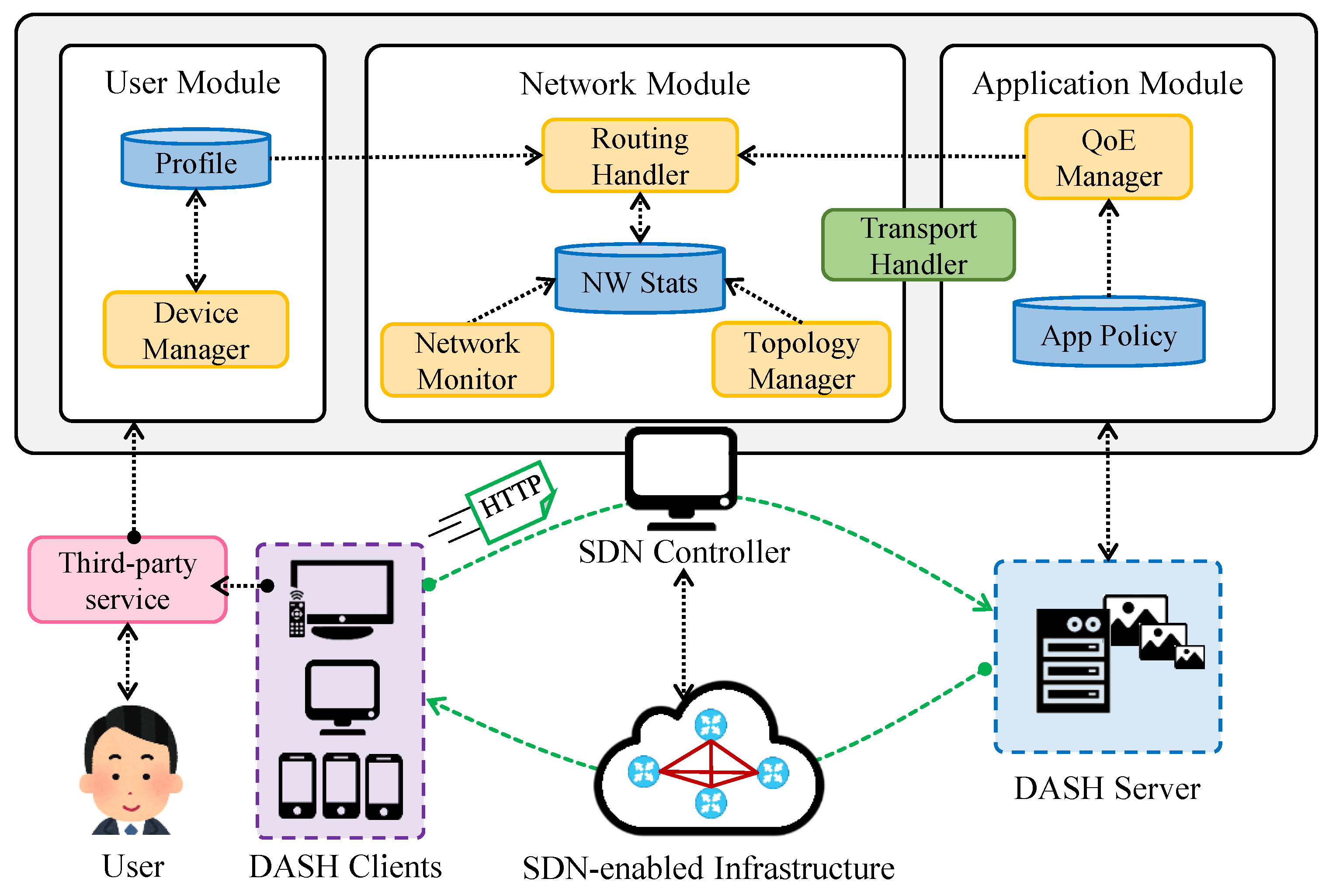
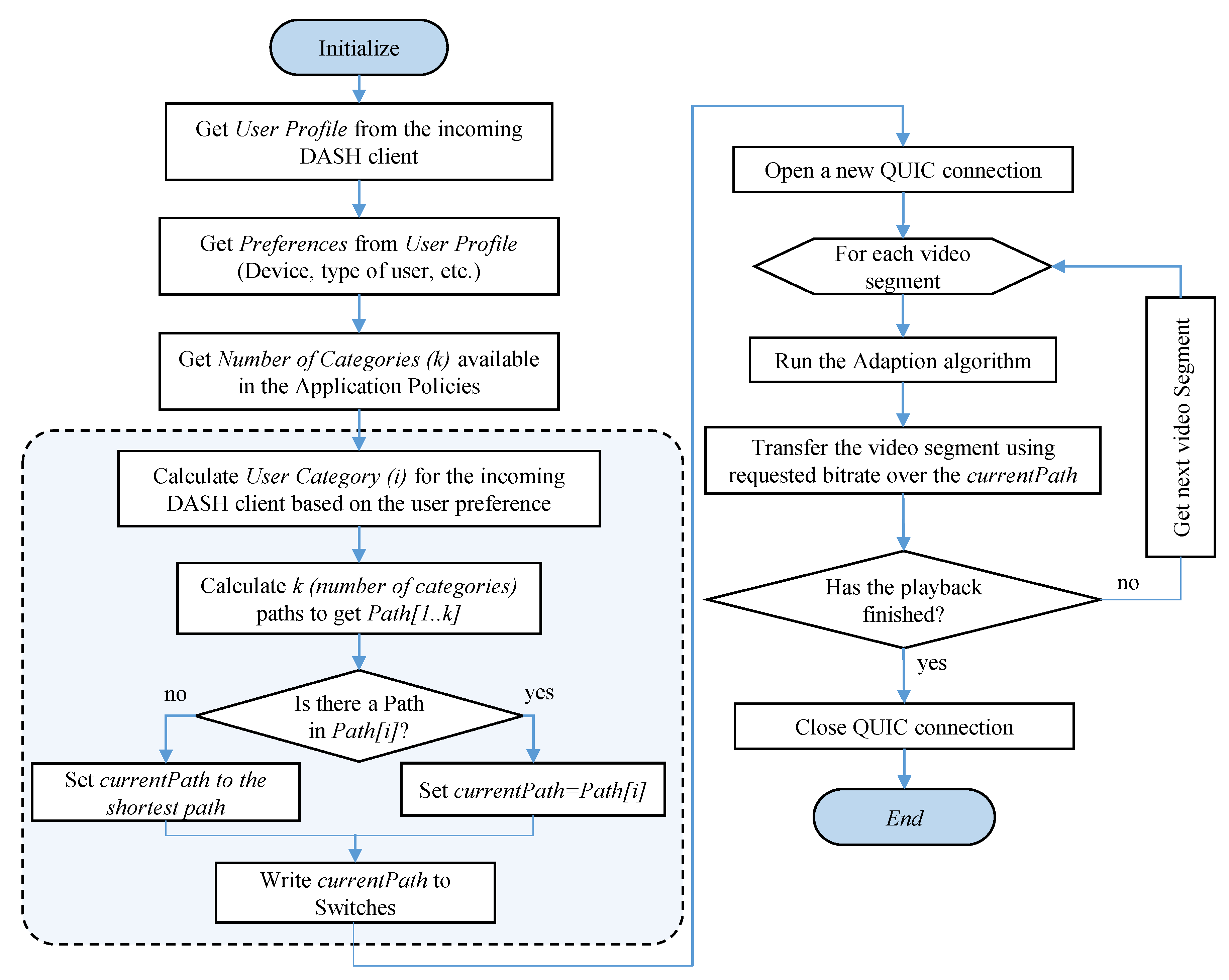
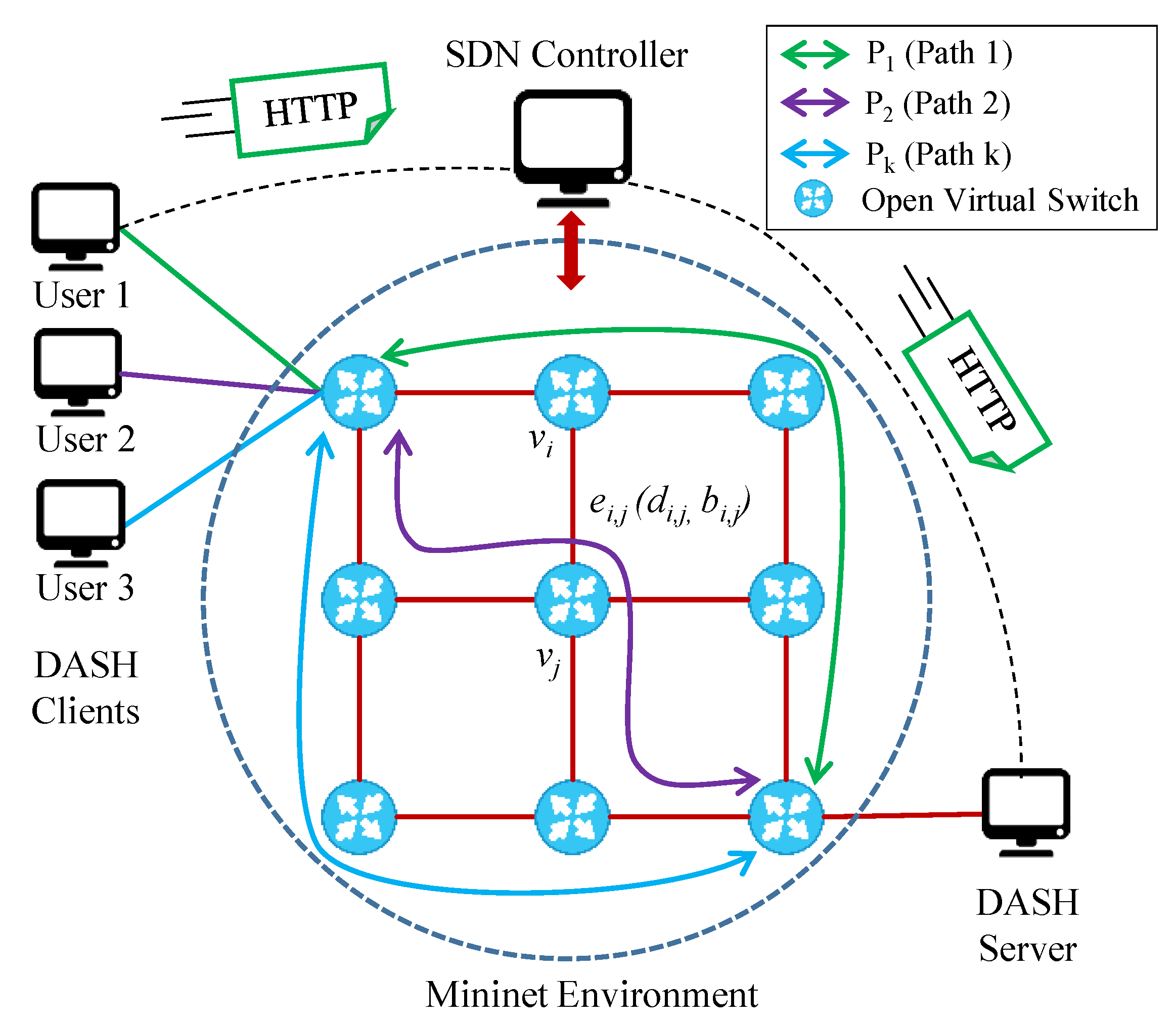

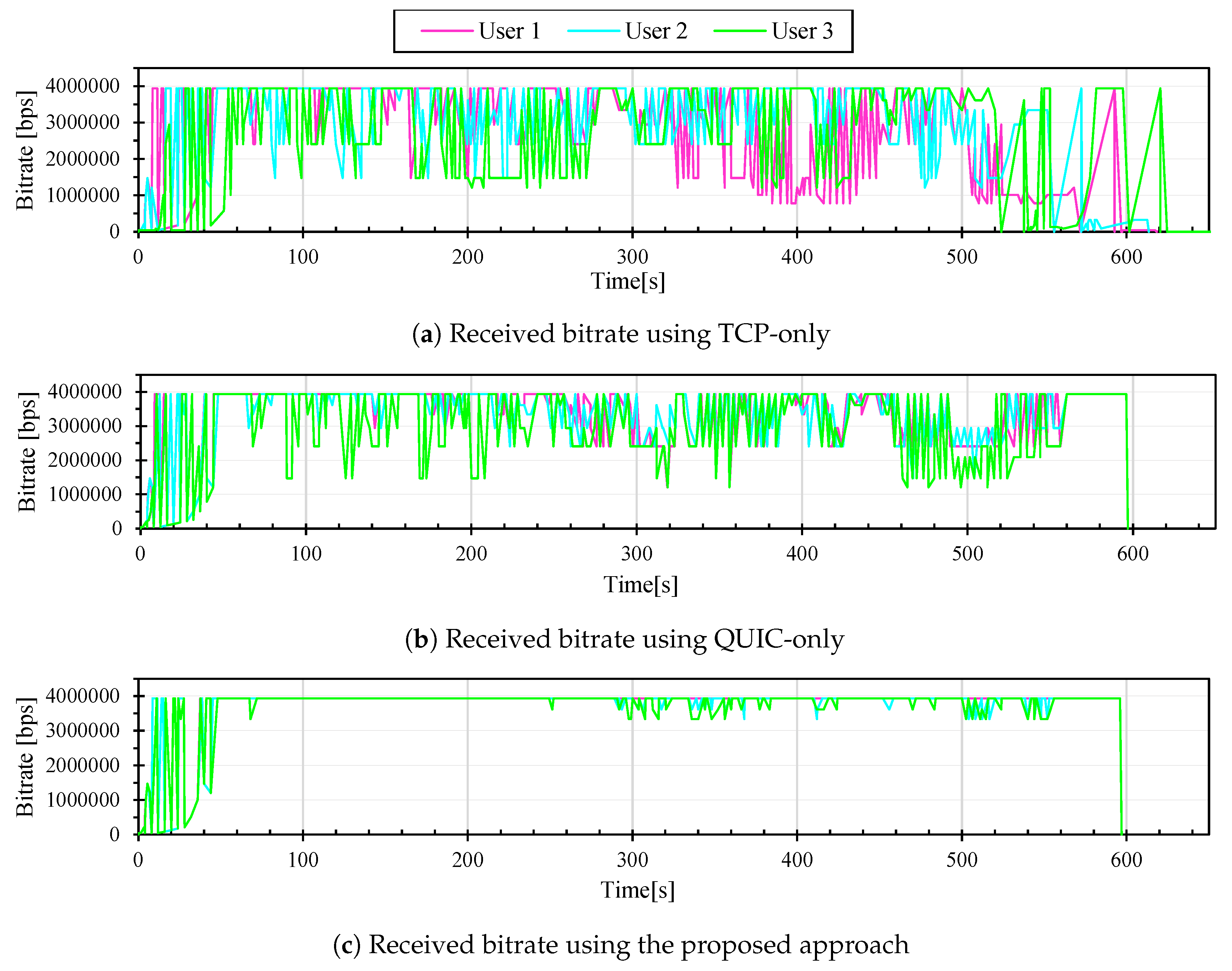
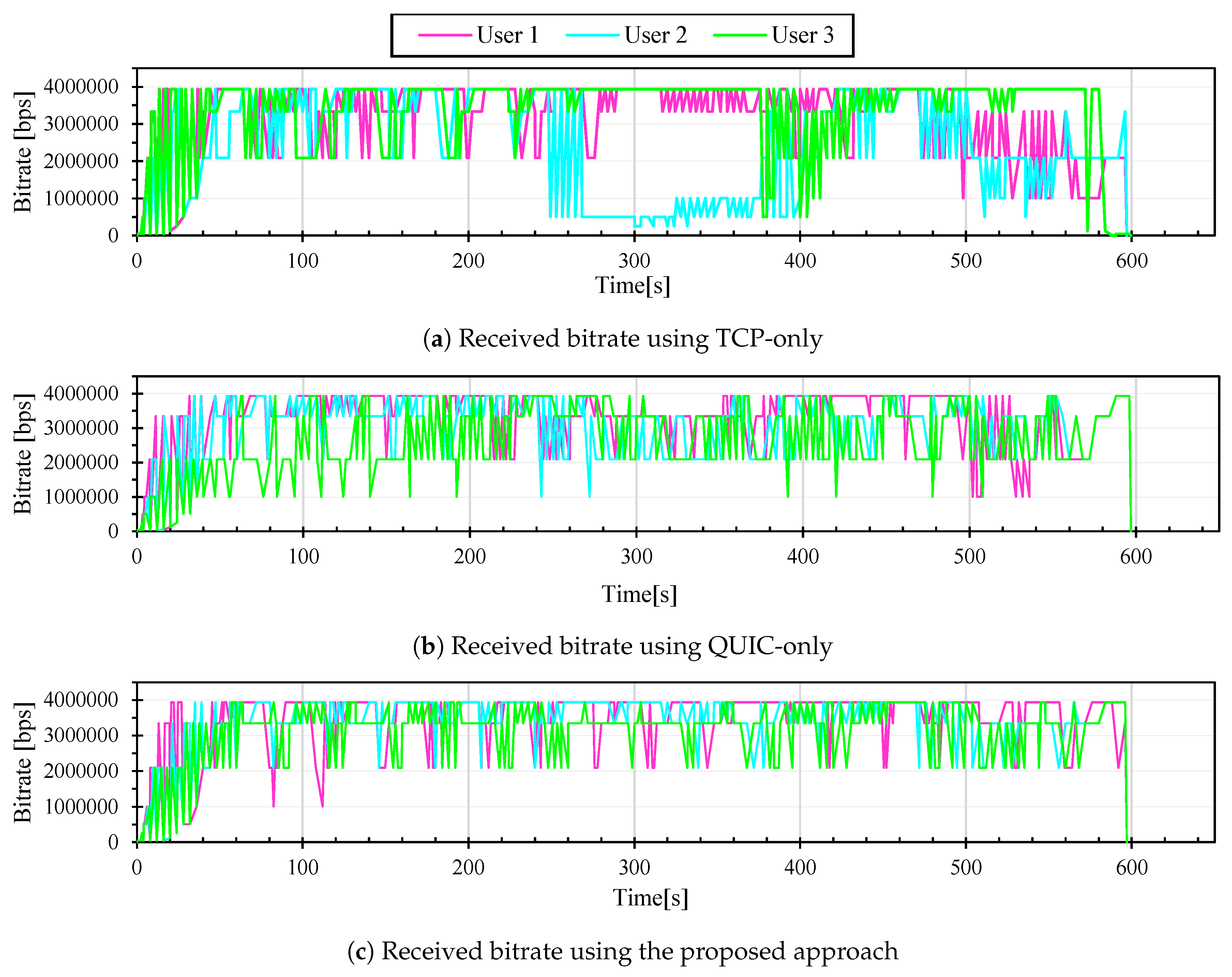
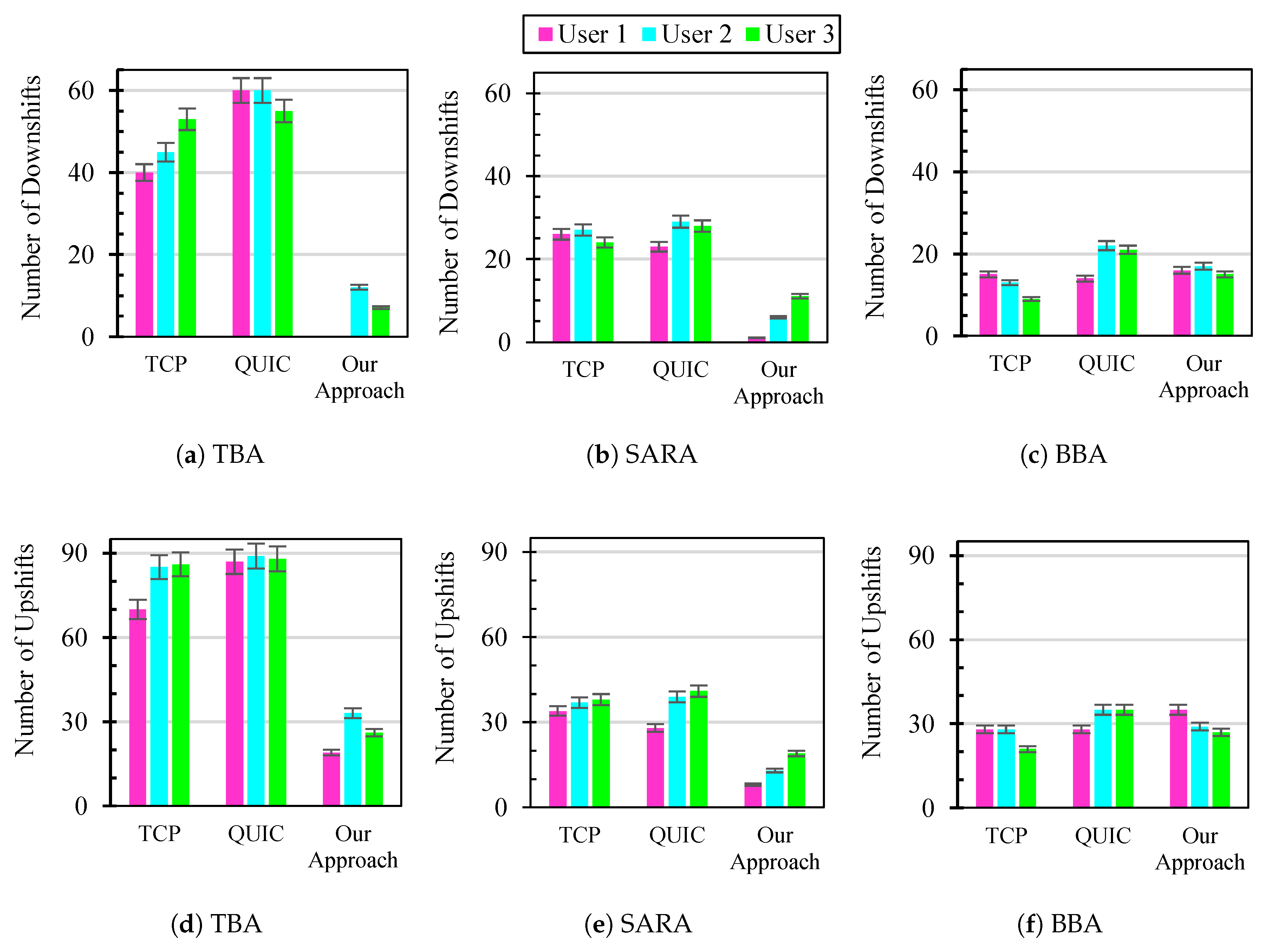
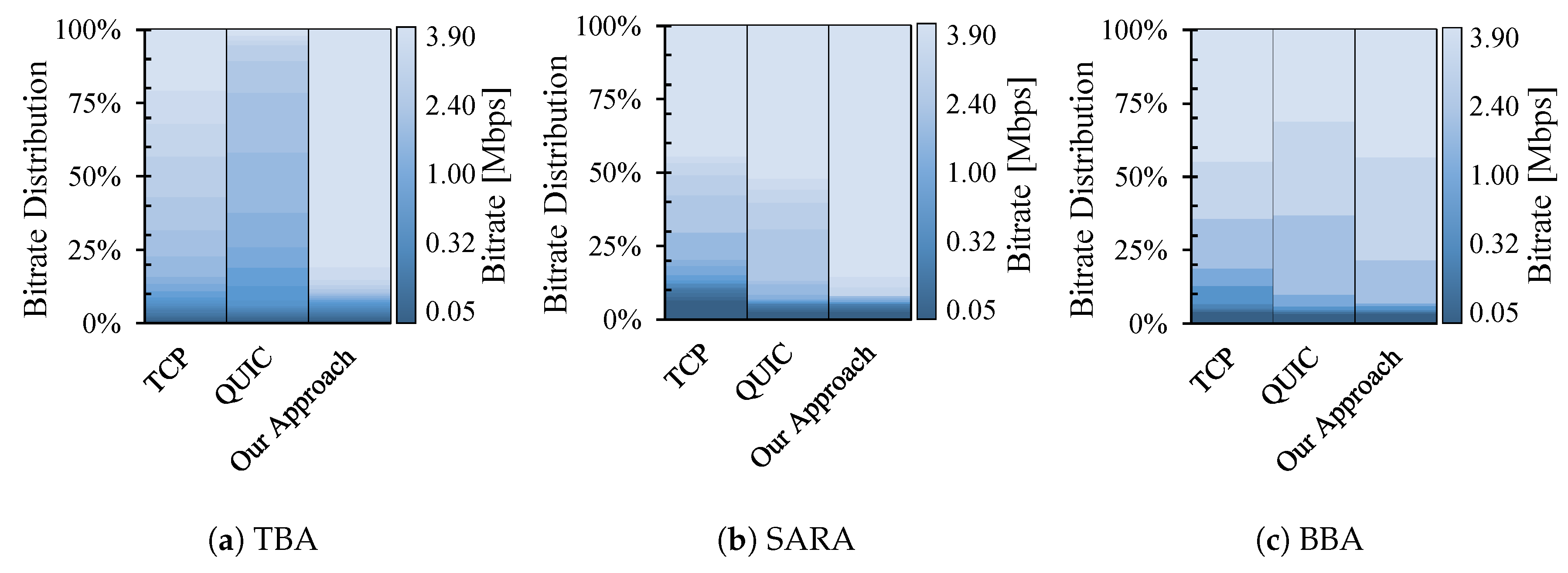
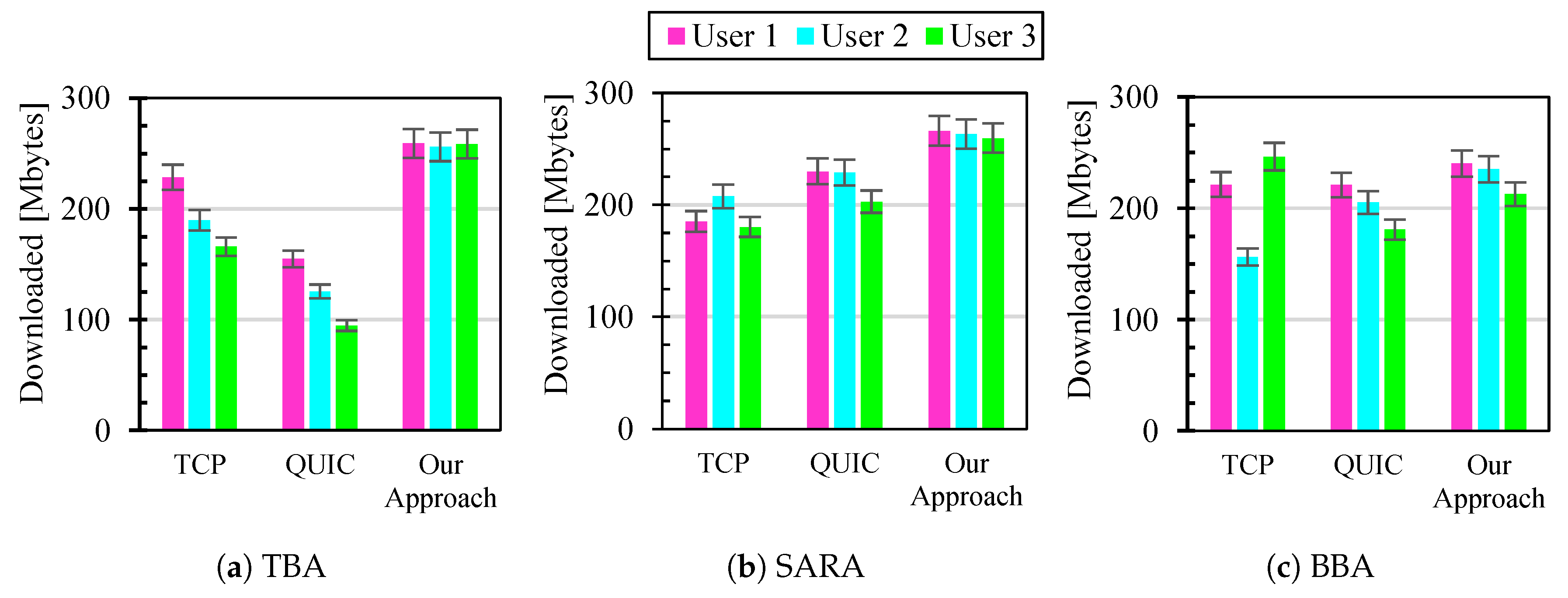
| Parameter | Value |
|---|---|
| Topology | 3 × 3 Grid |
| Bandwidth () | 10 Mbps for all links |
| Delay () | Randomly assigned (1, 3, and 5 ms) |
| # of DASH Clients | 3 (Xterm) emulating PCs |
| DASH Server | Simple HTTP Server |
| Controller | ODL Beryllium SR1 |
| Parameter | Value |
|---|---|
| Buffer size | 12 |
| Initial buffer | 2 |
| Initial factor | 0.75 |
| Reservoir | 0.2 |
| Cushion | 0.75 |
| Parameter | Value |
|---|---|
| Sample count | 5 |
| Initial buffering occupancy | 5 |
| Re-buffering bound I | 1 |
| Buffer lower threshold | 5 |
| Buffer upper threshold | 10 |
| User Category | Adaption Algorithm | |||||
|---|---|---|---|---|---|---|
| TBA | SARA | BBA | ||||
| # of Stalls | Time [s] | # of Stalls | Time [s] | # of Stalls | Time [s] | |
| 1 | 0 | 0 | 2 | 21.1 | 0 | 0 |
| 2 | 0 | 0 | 1 | 16 | 0 | 0 |
| 3 | 1 | 20 | 4 | 26 | 1 | 2.46 |
© 2019 by the authors. Licensee MDPI, Basel, Switzerland. This article is an open access article distributed under the terms and conditions of the Creative Commons Attribution (CC BY) license (http://creativecommons.org/licenses/by/4.0/).
Share and Cite
Guillen, L.; Izumi, S.; Abe, T.; Suganuma, T. SAND/3: SDN-Assisted Novel QoE Control Method for Dynamic Adaptive Streaming over HTTP/3. Electronics 2019, 8, 864. https://doi.org/10.3390/electronics8080864
Guillen L, Izumi S, Abe T, Suganuma T. SAND/3: SDN-Assisted Novel QoE Control Method for Dynamic Adaptive Streaming over HTTP/3. Electronics. 2019; 8(8):864. https://doi.org/10.3390/electronics8080864
Chicago/Turabian StyleGuillen, Luis, Satoru Izumi, Toru Abe, and Takuo Suganuma. 2019. "SAND/3: SDN-Assisted Novel QoE Control Method for Dynamic Adaptive Streaming over HTTP/3" Electronics 8, no. 8: 864. https://doi.org/10.3390/electronics8080864
APA StyleGuillen, L., Izumi, S., Abe, T., & Suganuma, T. (2019). SAND/3: SDN-Assisted Novel QoE Control Method for Dynamic Adaptive Streaming over HTTP/3. Electronics, 8(8), 864. https://doi.org/10.3390/electronics8080864





